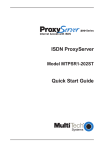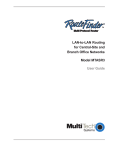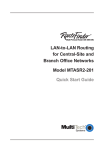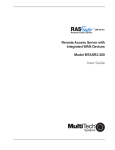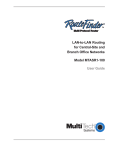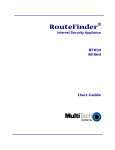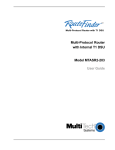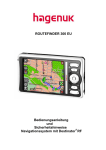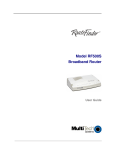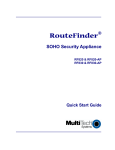Download Multitech RouteFinder MTASR3 User guide
Transcript
LAN-to-LAN Routing for Central-Site and Branch Office Networks Model MTASR3 Quick Start Guide Quick Start Guide 82087400 Revision A RouteFinder (Model MTASR3) This publication may not be reproduced, in whole or in part, without prior expressed written permission from Multi-Tech Systems, Inc. All rights reserved. Copyright © 1998, by Multi-Tech Systems, Inc. Multi-Tech Systems, Inc. makes no representations or warranties with respect to the contents hereof and specifically disclaims any implied warranties of merchantability or fitness for any particular purpose. Furthermore, Multi-Tech Systems, Inc. reserves the right to revise this publication and to make changes from time to time in the content hereof without obligation of Multi-Tech Systems, Inc. to notify any person or organization of such revisions or changes. Record of Revisions Revision Description A Manual released. All pages at revision A. (11/3/98) Patents This Product is covered by one or more of the following U.S. Patent Numbers: 5.301.274; 5.309.562; 5.355.365; 5.355.653; 5.452.289; 5.453.986. Other Patents Pending. TRADEMARK Trademark of Multi-Tech Systems, Inc. is the Multi-Tech logo. RouteFinder is a trademark of Multi-Tech Systems, Inc. Windows is a registered trademark of Microsoft in the U.S. and other countries. Adobe and Acrobat are trademarks of Adobe Systems, Inc. Multi-Tech Systems, Inc. 2205 Woodale Drive Mounds View, Minnesota 55112 (612) 785-3500 or (800) 328-9717 Fax 612-785-9874 Tech Support (800) 972-2439 BBS (612) 785-3702 or (800) 392-2432 Internet Address: http://www.multitech.com Fax-Back (612) 717-5888 Contents Introduction .................................................................................... 4 Related Documentation ................................................................. 5 Safety Warnings ............................................................................ 6 Unpacking your RouteFinder ......................................................... 7 Cabling your RouteFinder .............................................................. 8 Changing Shunt Positions ........................................................... 10 Loading your Software ............................................................ 12 Setting Up Your Remote User Database ..................................... 20 Setting Up the Dial-up Networking ............................................... 24 Loading Dial-Up Network Software .............................................. 32 Loading Your Protocol ................................................................. 34 Loading Client for Microsoft Networks ......................................... 36 Installing Your Modem ................................................................. 38 Limited Warranty ......................................................................... 38 Service ........................................................................................ 39 FCC Regulations for Telephone Line Interconnection .................. 39 Canadian Limitations Notice ........................................................ 42 Ringer Equivalence Number ........................................................ 43 European Community Directives ................................................. 43 iii RouteFinder MTASR3 Quick Start Guide Introduction Welcome to Multi-Tech's new RouteFinder™, model MTASR3, a Multi-Protocol Router for remote dial-in access and LAN-to-LAN routing capability. The RouteFinder is a remote access device that supports up to three concurrent dial-in sessions and IP or IPX remote access. The RouteFinder features a 10BaseT or 10Base5 port for local LAN connection, and Command Port for configuration. System management is provided through the command port using bundled Windows® based software which provides easy-to-use configuration menus. Æ Tech Systems Figure 1. RouteFinder MTASR3 4 Introduction Related Documentation This MTASR3 Quick Start Guide is intended to be used by qualified systems administrators and network managers. This quick start provides the necessary information for a qualified person to unpack, cable, load software, and configure the unit for proper operation. A detailed User Guide is also provided with your unit. This user guide provides in-depth information on the features and functionality of the RouteFinders. The User Guide is provided in disk form and is also available from our web site. The diskette media is produced using Adobe Acrobat for viewing and printing the user guide. To view or print your copy of the user guide, load Adobe Acrobat Reader on your system. Adobe Acrobat Reader can be downloaded from Adobe’s Web site at: http://www.adobe.com/prodindex/acrobat/roadstep.html Launch the Reader and select the .pdf file from the diskette. Viewing and printing a user guide from the web also requires that you have the Adobe Acrobat Reader loaded on your system. The User Guide is also available on Multi-Tech’s Web site at: http://www.multitech.com From the MTS homepage, click Support | Manuals | RouteFinder and choose the User Guide which will download the .pdf file. 5 RouteFinder MTASR3 Quick Start Guide Safety Warnings 6 1 Never install telephone wiring during a lightning storm. 2 Never install telephone jacks in wet locations unless the jack is specifically designed for wet locations. 3 Never touch uninsulated telephone wires or terminals unless the telephone line has been disconnected at the network interface. 4 Use caution when installing or modifying telephone lines. 5 Avoid using a telephone (other than a cordless type) during an electrical storm. There may be a remote risk of electrical shock from lightning. 6 Do not use the telephone to report a gas leak in the vicinity of the leak. Cabling Unpacking your RouteFinder Remove all items from the box. Æ Tech Systems MADE IN U.S .A MADE IN U.S.A Figure 3. Unpacking 7 RouteFinder MTASR3 Quick Start Guide Cabling your RouteFinder Cabling your RouteFinder involves making the proper Ethernet, WAN, Command Port, and Power connections. Figure 4 shows the back panel connectors and the associated cable connections. Table 2 details the procedures for connecting the cables to your RouteFinder. ETHERNET 10BASE T AUI LINK 3 RS232/V.35 LINK 2 RS232/V.35 COMMAND PORT LINK 1 RS232/V.35 POWER Power Connection Ethernet Connection T1 CSU/DSU or Comparable Link Device Command Port Connection Figure 4. Cable Connections 8 Cabling Table 2. Cabling Procedure Step Procedure 1 If one or more links need to be changed to a V.35 interface, perform the procedures in Table 3. 2 If additional RAM is needed, refer to the procedure in Chapter 2 of the User Guide. 3 Connect the RouteFinder to your PC with a standard RS232 cable with DB25 connectors on both ends. Plug one end of the cable into the DB25 Command Port on the RouteFinder. Connect the other end to the PC's serial port . See Figure 2. 4 To make the network connection, connect an RJ-45 (UTP) cable to the 10BaseT connector on the back panel or the male connector for a 10 BASE5 cable to the AUI connector. 5 Connect an RS232C/D or V.35 interface cable to the LINK 1 connector as shown in Figure 2-2. Connect the other end of the cable to the appropriate connector on the external link device. Connect the appropriate cables to LINK 2 and LINK 3 on the back of the unit. Connect the other ends of the cables to the external link devices. 6 Connect one end of the power supply to a live AC outlet, then connect the other end to the POWER connector on the RouteFinder as shown in Figure 2. The power connector is a 6-pin circular DIN connector. 7 Turn on power to the RouteFinder by setting the ON/OFF switch on the back panel to the ON position. At this time your RouteFinder is completely cabled and powered On. Proceed to the next section to load the RouteFinder software. 9 RouteFinder MTASR3 Quick Start Guide Changing Shunt Positions Table 3 provides the procedure for moving the link shunts before connecting the RouteFinder to an external composite link device that has a V.35 interface. Table 3. V.35 Shunt Procedure Step Procedure 1 Ensure that the external power supply is disconnected from the RouteFinder. 2 Turn the unit upside down and remove the cabinet mounting screw. See Figure 5. ® Tech Systems Enclosure Mounting Screw (center, back) 10 3 Figure 5. Cabinet Mounting Screw Turn the unit right side up and tilt the back down slightly and the base will slide out of the cabinet. 4 Position the unit with the LEDs toward you, as in Figure 6. 5 Pry the shunt out of the default RS232 position for the link being changed, then install the shunt in the V.35 position for that link. See Figure 6. Cabling Link 1 RS232 Shunt Position Link 1 V.35 Shunt Position Link 2 V.35 Shunt Position Link 3 V.35 Shunt Position 6 7 Figure 6. V.35 Shunt Slide the base back into the enclosure with the LEDs going toward the front and the back side grounding tabs pressing against the side of the cabinet. Turn the unit upside down and replace the cabinet mounting screw that was removed in step 2. ® Tech Systems Enclosure Mounting Screw (center, back) Figure 7. Replacing Cabinet Mounting Screw 8 Turn the unit right side up and return to Table 1 to connect the cables. 11 RouteFinder MTASR3 Quick Start Guide Loading your Software 1 Run Windows on the PC that is connected to the RouteFinder’s Command Port. 2 Insert the RouteFinder 3.00 Disk 1 into the disk drive on the PC that is connected to the RouteFinder. 3 Win3.1 users - access Run by clicking on the File menu in the Program Manager, then click Run. In the Run dialog box, type a:\setup.exe or b:\setup.exe (depending on the letter of your floppy disk drive) in the Command Line field and then click OK. Win95/NT users - click Start, then Run. In the Run dialog box click the down arrow and choose a:\setup or b:\setup (depending on the letter of your floppy disk drive), then click OK. 4 The Welcome screen is displayed. Press Enter or click Next> to continue. 5 12 Follow the on-screen instructions to install your RouteFinder software. Software 6 Press Enter or click Next> to continue. 7 When the Select Program Folder dialog box appears, double-click the word “RASFinder” and delete it (and preceding spaces, etc.) leaving the word “RouteFinder” in the text box; this will become the name of the icon group. Press Enter or click Next> to continue. 8 The next dialog box enables you to designate the COM port of the PC that is connected to the RouteFinder. On the Select Port field, click the down arrow and choose the COM port of your PC (COM1 -- COM4) that is connected to the RouteFinder. 13 RouteFinder MTASR3 Quick Start Guide Click OK to continue. 9 The Setup complete dialog box is displayed. Click the Finish button to continue. 10 The following message is displayed. 11 Click No to skip the upgrade process. The following message appears: 14 Software 12 Click Yes to download the default setup. Clicking on the No button prevents the defaults from being downloaded to the RouteFinder. 13 The Novell IPX Protocol Default Setup dialog box appears. Note: To configure your RouteFinder, you now will use a series of dialog boxes -- Novell IPX Protocol Default Setup, IP Protocol Default Setup, and WAN Ports Default Setup. 14 If your network protocol is IPX, continue with the following steps. However, if your network protocol is IP, click the IPX Routing Enable check box to disable IPX, then click OK and proceed to step 18. 15 Router Name: If this is the only RouteFinder on your network, you can use the default Router Name (MTROUTER); otherwise, you must assign a new Router Name in this field. The Router Name can be any printable 15 RouteFinder MTASR3 Quick Start Guide ASCII string of up to 47 characters. The RouteFinder will use this name to advertise its service in the IPX internetwork. 16 Ethernet: You can enable Auto Learn Ethernet Network Numbers by leaving the default (Yes) checked, or you can manually assign the network numbers after disabling the Auto Learn option by clicking on No. If no file server is connected to the Ethernet segment, then you should select No. If you leave Auto Learn enabled, the RouteFinder will learn the IPX network numbers from the file server. If you disable Auto Learn, record in the space below the network numbers assigned by the network file server for each of the four frame types [(Raw (802.3), LLC (802.2), EthernetII (Type II), and SNAP]. Also record here the Network numbers for WAN 1, WAN 2, and WAN 3. RAW (802.3) Frames Network Number _____________ LLC (802.2) Frames Network Number ______________ TYPE_II Frames Network Number _________________ SNAP Frames Network Number ___________________ WAN 1 Network Number _________________________ WAN 2 Network Number _________________________ WAN 3 Network Number _________________________ When you manually assign network numbers, make sure they match the network numbers assigned to your local file server (if any). 17 WAN 1, WAN 2, and WAN 3: Click the associated check box if any port is to be disabled; otherwise, leave the Enable checked, double-click the Network number text box, and enter the WAN Network number. The WAN network number must be the same as at the RouteFinder on the other end of a LAN-to-LAN link. 16 Software The WAN network numbers have to be assigned by the network administrator and must be unique throughout the entire internetwork. Note: Unlike the Ethernet port, the WAN ports do not have the capability of learning the network number (i.e., the WAN ports do not have a file server). 18 Click OK when you are satisfied with your selections. 19 If you clicked OK from the Novell IPX Protocol Default Setup dialog box (step 13), the IP Protocol Default Setup dialog box is now displayed. 20 To change the IP parameters, proceed to the next step. Otherwise, click OK to open the WAN Ports Default Setup dialog box, then advance to step 23. 21 The default Ethernet IP Address has to be changed to your unique LAN address. In the Ethernet group, change the default IP Address, Subnet Mask, and Frame Type to the values assigned to your LAN port. 22 For any WAN ports that are enabled, enter the Address, Subnet, and Remote Address numbers. 23 Click OK when you are satisfied with your selections. 24 The WAN Ports Default Setup dialog box appears with all three WAN Ports enabled, the speed set at 115200, and the Modem Type defaulted to Multi-Tech 56K Socket Modem. 17 RouteFinder MTASR3 Quick Start Guide 25 If any WAN port is being set up to answer a call, click its Answering check box to enable it; otherwise, (i.e., for dial-out ports) enter the telephone number to be dialed in the Dial Number field. 26 Click OK when you are satisfied with your selections. 27 The Checking Router dialog box is displayed. Click OK. Next, the Writing Setup dialog box (with the current date and the file size in bytes) is displayed as the software sends the configuration file to the RouteFinder. 18 Software Next, the Rebooting dialog box is displayed. 28 Check to ensure that the Fail LED on the RouteFinder goes Off after the download is complete and the RouteFinder is rebooted (the Rebooting dialog box goes away). 29 Win3.1 users - you are returned to your Program Manager where the RouteFinder Program Group and Program Items (RouteFinder icons) have been created. Win95/NT users - you are returned to your desktop. Your RouteFinder is operational at this time. 19 RouteFinder MTASR3 Quick Start Guide Setting Up Your Remote User Database The remote user database lets you gather information about your remote users. You can add remote users, remove users from the database, or you can edit information in the database. 1 Win3.1 users - From the Program Manager, click the Remote User Data Base icon. Win95/NT users - From your desktop, click the Start button, point to Programs, then RouteFinder, and then click Remote User Data Base. The Users List dialog box is displayed. 20 Dial-Up Network 2 Click the Add User button and the Add Users dialog box is displayed. 3 Build your user database by filling in the following fields for each user. User Name. The User Name can have as many as 39 characters. All printable characters are permitted; however, no blanks are allowed in the user name. In dial-in and dial-out applications, the user name is treated as a case insensitive string. 21 RouteFinder MTASR3 Quick Start Guide User Password. The User Password can have as many as 7 characters. In places where the password is used as a character string, it is treated as a case insensitive string. Elsewhere (PPP’s CHAP), it is treated as a case sensitive pattern. Call Back You have to click this check box in order to access the following three Call Back functions. Call Back Security Enabled This parameter is of use in dial-in applications where the user is required to be called back at a specific location. Enabling this parameter results in having the administrator assigning the call back parameters. Leave this function disabled if the user is to be allowed to choose the call back number and the call back delay. Call Back Number The callback number is editable only if callback security is enabled (checked). This is the number where the user will be called back. The user cannot choose the location where he wants to be called back. Call Back Delay Call back delay is editable only if callback security is enabled. This specifies the duration after which the user will be called back at the administrator-assigned number. Protocols This lets you select the protocol(s) in which the user is allowed to dial into the RouteFinder. Dial In Ports This enables you to select the port over which the user is permitted to dial into the RouteFinder. 22 Dial-Up Network Dial Out Ports This enables you to select the port over which the user is permitted to dial out from the RouteFinder. 4 After each user is defined on the Add Users screen, click the OK button to display the updated Users List dialog box. Click the Add User button to continue adding users to your database. 5 When you have added all your users to the data base, from the Users List dialog box, click the Download button to load the database into the RouteFinder. 23 RouteFinder MTASR3 Quick Start Guide Setting Up the Dial-up Networking Setting up a dial-up network involves checking for hardware components and if the necessary software is loaded and configured properly. The setting up a dial-up network procedure looks at what software is loaded and if it is not loaded, a separate procedure is provided so that you can continue down a single path to the point of making a call on your network. Separate procedures are provided for loading the dial-up network software, TCP/IP, and the client for Microsoft networks. 1 Check if the Dial-up Networking software is installed. Double-click the My Computer icon. You should see an icon labeled Dial-up Networking in the My Computer window. If you cannot find the Dial-Up Networking icon in My Computer, you need to load it, refer to the Loading Dialup Networking Software procedure in this section. 2 24 Verify that your Protocol is installed. Double-click the Control Panel icon. In the Control Panel window, doubleclick the Network icon. A Network Configuration window will appear. Dial-Up Network A list of items will appear in a panel under the label The following network components are installed:. 3 If your network protocol is installed, continue with the next step, Select the Primary Network Logon. If your network protocol is not installed, refer to Loading your Protocol procedure in this section. After installing the protocol, allow your computer to reboot. Your computer may ask you if you want to restart it now. Click the Yes button. 4 Select the Primary Network Logon. In the Primary Network Logon drop-down list, select your Client for _________ Networks. 5 Exit the software. Click the OK button at the bottom of the window. 25 RouteFinder MTASR3 Quick Start Guide 6 Install your modem. If you are using a new modem and have NOT installed it already, you will need to install it now, refer to the Installing Your Modem procedure in this section. 7 Create a Dial-up connection icon for the RouteFinder. 8 Open the Dial-up Networking software. Double-Click the Dial-up Networking icon in the My Computer window. 9 Select Make New Connection. Double-click the Make New Connection icon. 10 Name the new connection. In the box labeled Type a name for the computer you are dialing, enter the name of your RouteFinder. The network administrator should provide you with the RouteFinder name. 26 Dial-Up Network 11 Continue to the next window. Click the Next> button at the bottom of the window. 12 Enter your RouteFinder’s telephone number. In the Telephone number box, enter your RouteFinder’s telephone number. Do NOT enter the area code in the "Area code" box unless the call is a long-distance call for you. 13 Continue to the next window. Click the Next> button at the bottom of the window. 14 Exit the window. Click the Finished button at the bottom of the window. You should now see a new Dial-up icon labeled with the name you gave your RouteFinder. 15 Configure your new RouteFinder Dial-up icon. Click your RouteFinder icon that you just created. Click the file menu button at the top of the Dial-up Networking window, then select the Properties option. A new window will appear. 27 RouteFinder MTASR3 Quick Start Guide 16 Select Server types. Click the Server Type button. A window will appear. 17 Select server type. Near the top of the window you will see a Type of Dial-Up Server drop-down list. Select the "PPP: Windows 95, Windows NT 3.5, Internet" option. 18 Ensure that all Advanced Options: are not checked. 19 Select your network protocol from Allowed Network protocols: Click the check box to the left of your network protocol. NetBEUI is not supported. If you check IPX/SPX Compatible protocol, proceed to step 24. If you check TPC/IP protocol, proceed to the next step. 28 Dial-Up Network 20 Select Specify Name Server address. If the circle to the left of the Specify Name Server address label does NOT have a dark center, Click it. 21 Enter the Primary DNS server address. In the "Primary DNS" server box, enter the Primary DNS number supplied by your network administrator; e.g., 190.2.9.1. In the "Secondary DNS" server box, enter the Secondary DNS number supplied by your network administrator; e.g., 190.2.9.2. 22 Select Use IP header compression. If the circle to the left of the Use IP header compression label does NOT have a dark center, Click it. 29 RouteFinder MTASR3 Quick Start Guide 23 Select Use default gateway on remote network. If the circle to the left of the Use default gateway on remote network label does NOT have a dark center, Click it. 24 Exit the TCP/IP Settings window. Click the OK button. This button will appear two more times. Each time, Click it. You will be returned to the "Dial-up Networking" window. 25 Dial in. Double-click your RouteFinder icon. A Connect To window will appear. 26 Enter your User name. Your User name is provided by your network administrator from his/her Remote User Data Base. In the User name box, enter your user name. 27 Enter your Password. In the Password box, enter your password. Your Password is provided by your network administrator from his/her Remote User Data Base. 28 Save your Password. 30 Dial-Up Network Note: This step is OPTIONAL. If you are concerned about the security of your account, do NOT save your password. You will have to manually reenter it every time you log on. To save your password, click on the Save password check box. 29 IF YOU HAVE CALL WAITING, select Dial Properties. Click the Dial Properties button. A new window will appear. 30 Turn on the call waiting disabling option. If your call waiting is not disabled while you are connected to the Internet, the line "Clicks" announcing incoming calls will break your connection. Click the check box to the left of the This location has call waiting. To disable it, dial label. A checkmark mark should appear in the box. 31 Set the call waiting disabling option. To the right of the label is a pull-down menu. Click it and select the string needed to disable call waiting on your phone line: For Touchtone Phones: *70 For Rotary Phones: 1170 31 RouteFinder MTASR3 Quick Start Guide This string will only disable call waiting for a single phone call, and call waiting will automatically turn back on as soon as you hang up. 32 Exit the Dialing Properties window. Click OK to return to the Connect To window. 33 Connect to your RouteFinder. Click the Connect button. Loading Dial-Up Network Software 1 Locate your Windows 95 CD-ROM installation disk or floppies. Put it in the CD-ROM drive (or your floppy drive) and wait for it to show up on your desktop. 2 Select Add/Remove Programs. Double-click the My Computer icon. In the My Computer window, double-click the Control Panel icon. Double-click the Add/Remove Programs icon. 3 Select the Windows Setup tab. At the top of the window, you will see buttons that look like file folder tabs. Click the Windows Setup tab. 32 Dial-Up Network 4 Select Communications. Click the check box to the left of the Communications option in the window, so that it shows a checkmark. Make sure that this is the ONLY box that shows a checkmark - if any other boxes are marked, click them so that the checkmark disappears. Double-click the Communications option in the window. A Communications window appears. 5 Select Dial-up Networking. Click the check box next to the "Dial-up Networking" option so that a checkmark appears in it. 6 Click the OK button. 7 Click the OK button at the bottom of the window. The computer will now install the software. 8 Reboot your computer. A window will appear asking whether it is OK for the computer to restart. Click Yes. 9 Check that the software is installed correctly. Click the My Computer icon. You should now see an icon labeled "Dial-up Networking." 33 RouteFinder MTASR3 Quick Start Guide Loading Your Protocol 34 1 From the Control Panel window, click the Network icon. 2 From the Network window, click the Add button. The Select Network Component Type window with a list of options will appear. Dial-Up Network 3 Open the protocol options window. Double-click the Protocol option. The Select Network Protocol window will appear with protocol options. 4 Select the Manufacturer of your protocol. Click the Manufacturer of your protocol option on the left side of the window to highlight it. A list of options will appear at the right side of the window. 5 Select your Network Protocol. Click your Network Protocol option at the right side of the window. 6 Exit the add option. Click the OK button. You are returned to the Network dialog box. Continue with Setting Up the Dial-up Networking and Select the Primary Network Logon. 35 RouteFinder MTASR3 Quick Start Guide Loading Client for Microsoft Networks 36 1 From the Control Panel window, click the Network icon. 2 From the Network window, click the Add button. The Select Network Component Type window with a list of options will appear. How to Get a Copy of the User Guide 3 Open the client options window. Double-click the Client option. The Select Network Client window will appear with client options. 4 Select the Manufacturer of your client. Click the Manufacturer of your client option on the left side of the window to highlight it. A list of options will appear at the right side of the window. 5 Select your Network Client. Click your Network Client option at the right side of the window. 6 Exit the add option. Click the OK button. 37 RouteFinder MTASR3 Quick Start Guide Installing Your Modem Install your modem. If you are using a new modem and have NOT installed it already, you will need to install it now. 1 Select Add New Hardware. In the Control Panel window, Double-click the Add New Hardware icon. 2 Follow the instructions shown by Windows 95. You will be given a short, simple series of instructions by Windows 95. Windows 95 will do most of the work of configuring your modem with its "sniff and sense" software. Limited Warranty Multi-Tech Systems, Inc. (“MTS”) warrants that its products will be free from defects in material or workmanship for a period of two years from the date of purchase, or if proof of purchase is not provided, two years from date of shipment. MTS MAKES NO OTHER WARRANTY, EXPRESSED OR IMPLIED, AND ALL IMPLIED WARRANTIES OF MERCHANTABILITY AND FITNESS FOR A PARTICULAR PURPOSE ARE HEREBY DISCLAIMED. This warranty does not apply to any products which have been damaged by lightning storms, water, or power surges or which have been neglected, altered, abused, used for a purpose other than the one for which they were manufactured, repaired by the customer or any party without MTS’s written authorization, or used in any manner inconsistent with MTS’s instructions. MTS’s entire obligation under this warranty shall be limited (at MTS’s option) to repair or replacement of any products which prove to be defective within the warranty period, or, at MTS’s option, issuance of a refund of the purchase price. Defective products must be returned by Customer to MTS’s factory transportation prepaid. MTS WILL NOT BE LIABLE FOR CONSEQUENTIAL DAMAGES AND UNDER NO CIRCUMSTANCES WILL ITS LIABILITY EXCEED THE PURCHASE PRICE FOR DEFECTIVE PRODUCTS. 38 Warranty, Service and Regulatory Information Service Multi-Tech has an excellent staff of technical support personnel available to help you get the most out of your Multi-Tech product. Refer to your RouteFinder User Guide for Warranty and Service information. FCC Regulations for Telephone Line Interconnection 1 This equipment complies with Part 68 of the Federal Communications Commission (FCC) rules. On the outside surface of this equipment is a label that contains, among other information, the FCC registration number and ringer equivalence number (REN). If requested, this information must be provided to the telephone company. 2 As indicated below, the suitable jack (Universal Service Order Code connecting arrangement) for this equipment is shown. If applicable, the facility interface codes (FIC) and service order codes (SOC) are shown. An FCC-compliant telephone cord and modular plug is provided with this equipment. This equipment is designed to be connected to the telephone network or premises wiring using a compatible modular jack which is Part 68 compliant. See installation instructions for details. 3 The ringer equivalence number (REN) is used to determine the quantity of devices which may be connected to the telephone line. Excessive REN’s on the telephone line may result in the devices not ringing in response to an incoming call. In most, but not all areas, the sum of the REN’s should not exceed five (5.0). To be certain of the number of devices that may be connected to the line, as determined by the total REN’s, 39 RouteFinder MTASR3 Quick Start Guide contact the telephone company to determine the maximum REN for the calling area. 4 If this equipment causes harm to the telephone network, the telephone company will notify you in advance that temporary discontinuance of service may be required. But if advance notice isn’t practical, the telephone company will notify the customer as soon as possible. Also, you will be advised of your right to file a complaint with the FCC if you believe it is necessary. 5 The telephone company may make changes in its facilities, equipment, operations, or procedures that could affect the operation of the equipment. If this happens, the telephone company will provide advance notice in order for you to make necessary modifications in order to maintain uninterrupted service. 6 If trouble is experienced with this equipment (the model of which is indicated below) please contact Multi-Tech Systems, Inc., at the address shown below for details of how to have repairs made. If the equipment is causing harm to the telephone network, the telephone company may request you remove the equipment from the network until the problem is resolved. 7 No repairs are to be made by you. Repairs are to be made only by Multi-Tech Systems or its licensees. Unauthorized repairs void registration and warranty. 8 This equipment cannot be used on public coin service provided by the telephone company. Connection to Party Line Service is subject to state tariffs. (Contact the state public utility commission or corporation commission for information.) 9 If so required, this equipment is hearing-aid compatible. Manufacturer: Trade Name: Model: FCC Registration Number: Ringer Equivalence: 40 Multi-Tech Systems, Inc. RouteFinder MTASR3 AU7USA-24992-M5-E 0.6B Warranty, Service and Regulatory Information Modular Jack: RJ11 Service Center in the USA: Multi-Tech Systems, Inc. 2205 Woodale Drive Mounds View, MN 55112 (800) 328-9717 (612) 785-3500 (612) 785-9874 FAX NOTE: This equipment has been tested and found to comply with the limits for a Class B digital device, pursuant to Part 15 of the FCC Rules. These limits are designed to provide reasonable protection against harmful interference when the equipment is operated in a residential installation. This equipment generates, uses and can radiate radio frequency energy, and if not installed and used in accordance with the instructions, may cause harmful interference to radio communications. However there is no guarantee that interference will not occur in a particular installation. If this equipment does cause harmful interference to radio or television reception, which can be determined by turning the equipment off and on, the user is encouraged to try to correct the interference by one or more of the following measures: Reorient or relocate the receiving antenna Increase the separation between the equipment and receiver. Connect the equipment into an outlet on a circuit different from that to which the receiver is connected. Consult the dealer or an experienced radio/TV technician for help. This device complies with Part 15 of the FCC rules. Operation is subject to the following two conditions: (1) This device may not cause harmful interference. (2) This device must accept any interference that may cause undesired operation. Warning: Changes or modifications to this unit not expressly approved by the party responsible for compliance could void the user's authority to operate the equipment. 41 RouteFinder MTASR3 Quick Start Guide Canadian Limitations Notice Notice: The ringer equivalence number (REN) assigned to each terminal device provides an indication of the maximum number of terminals allowed to be connected to a telephone interface. The termination of a interface may consist of any combination of devices subject only to the requirement that the sum of the ringer equivalence numbers of all the devices does not exceed 5. Notice: The Industry Canada label identifies certificated equipment. This certification means that the equipment meets certain telecommunications network protective, operational and safety requirements. The Industry Canada does not guarantee the equipment will operate to the user’s satisfaction. Before installing this equipment, users should ensure that it is permissible to be connected to the facilities of the local telecommunications company. The equipment must also be installed using an acceptable method of connection. The customer should be aware that compliance with the above conditions may not prevent degradation of service in some situations. Repairs to certified equipment should be made by an authorized Canadian maintenance facility designated by the supplier. Any repairs or alterations made by the user to this equipment, or equipment malfunctions, may give the telecommunications company cause to request the user to disconnect the equipment. Users should ensure for their own protection that the electrical ground connections of the power utility, telephone lines and internal metallic water pipe system, if present, are connected together. This precaution may be particularly important in rural areas. Caution: Users should not attempt to make such connections themselves, but should contact the appropriate electric inspection authority, or electrician, as appropriate. 42 Warranty, Service and Regulatory Information This digital apparatus does not exceed the Class B limits for radio noise emissions from digital apparatus set out in the Radio Interference Regulation of the Canadian Department of Communications. Le présent appareil numérique n’émet pas de bruits radioélectriques dépassant les limites applicables aux appareils numériques de la classe B prescrites dans le Règlement sur le brouillage radioélectrique édicté par le ministère des Communications du Canada. Ringer Equivalence Number Notice: The ringer equivalence number (REN) assigned to each terminal device provides an indication of the maximum number of terminals allowed to be connected to a telephone interface. The termination on an interface may consist of any combination of devices subject only to the requirement that the sum of the ringer equivalence numbers of all the devices does not exceed 5. European Community Directives The CE mark is affixed to the enclosed Multi-Tech product to confirm compliance with the following European Community Directives: Council Directive 89/336/EEC of 3 May 1989 on the approximation of the laws of Member States relating to electromagnetic compatibility; and Council Directive 73/23/EEC of 19 February 1973 on the harmonization of the laws of Member States relating to electrical equipment designed for use within certain voltage limits; both amended by Council Directive 93/68/EEC of 22 July 1993 on the harmonization of CE marking requirements. 43 82087400













































